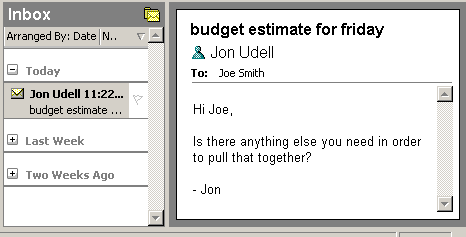
InfoWorld's special report on Office 2003 appears this week. I was interested to compare our take with that of the New York Times. David Pogue wrote:
In Office 2003, Microsoft has made shockingly few changes to Word, Excel and PowerPoint. The message seems to be: "You people didn't like it when we piled on features? O.K., fine. Let's see how you like it when we add none at all. [New York Times
In a brief paragraph, he summarized one of the major advances that I've devoted many articles to:
Another juicy corporate morsel: Office documents can now incorporate what's called XML code (extensible markup language). That statement may mean nothing to you, but it will give corporate geeks dilated pupils and sweaty palms. XML can tie together specially defined areas in ordinary Word and Excel documents with big, humming corporate databases. Fill in the blanks of the company expense report, and the company's SQL database can inhale and process it automatically.
Given how Microsoft has soft-pedaled the XML infrastructure now woven into Office, I can see why Pogue relegated it to a footnote. And the truth is that it will probably take at least one more turn of the crank before XML in Office, or indeed in any mainstream application, makes this kind of scenario -- which I suggest in the lead story -- a routine thing:
An entire document can always be saved as XML, but you can bind just a subset of a document to a schema and manage it accordingly. It's always been possible to attach metadata to an Office document using global properties. With this approach, the metadata can appear anywhere in the document. A paragraph or section, for example, might be assigned to a category and thus exposed to a category-aware search engine. [InfoWorld.com]
In a separate story, I looked at the collaborative modes now available when you use Office apps together with SharePoint and Live Communication Server. First, Outlook users get what Apple's Mail.app users have had for some time now: presence indicators in the email client:
Likewise in SharePoint:
And perhaps most interestingly, in the SharePoint pane of Excel (or Word):
Pretty hot stuff! I concluded:
E-mail, the intranet, and IM have been on a collision course for some time now. I am delighted to see Microsoft not only embracing all three modes but also looking for ways to weave them together. Yet I can't avoid a sense of deja vu. In the 1990s, Netscape tried something similar, offering a suite of collaboration servers and a matching suite of clients. There were compelling benefits, but also a lot of moving parts. I feel the same way about Office, Exchange, SharePoint, and Live Communication Server. Users will find no single unifying theme akin to the Groove shared space. Administrators will have to install and manage three or four sets of clients and servers. The new capabilities are exciting, but it'll take lots more integration to make Office-based collaboration a seamless and manageable experience. [InfoWorld.com]
That conclusion was reinforced for me this weekend at BloggerCon, during Joi Ito's wonderful session about online community. Even highly advanced bloggers are often unfamiliar with alternate modes such as IRC and Wiki. Helping users to integrate these different communication modes and cognitive styles is going to be a real challenge, but it's great to see movement in that direction.
Former URL: http://weblog.infoworld.com/udell/2003/10/06.html#a819